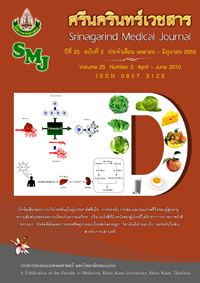Balance, Fall and Quality of Life of Regular and Non-regular Exercise Elderly
Abstract
Objectives: To compare balance performance, incidences of fall and quality of life of regular and non-regular exercise elderly
Methods: The study cross-sectionally recruited 300 well-functioning older adults, aged 60 – 80 years both males and females. The eligible subjects were assigned into the regular and non-regular exercise groups by using a questionnaire. Balance performances were investigated by using the Berg Balance Scale (BBS) and Timed Up and Go Test (TUGT). Incidences of fall and quality of life were assessed by using questionnaires.
Results: Subjects were mostly females which the mean ages of subjects in non-regular exercise group were 69.65 + 5.09 years and regular exercise group were 68.12 + 4.88 years. There were no significant differences of baseline demographics of subjects in both groups. The findings demonstrated that regular exercise subjects had better balance performances and quality of life with a lower incidence of fall than non-regular exercise subjects. Balance performance of subjects in both groups were significant differences (p<0.001).
Conclusion: The results imply that regular exercise with moderate intensity delays the deterioration of body systems involved with balance control and mobility that likely occurs in elderly.
Keywords: Elderly, Balance, Fall, Exercise, Quality of Life




